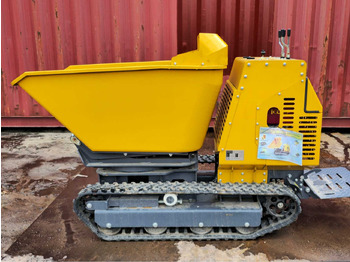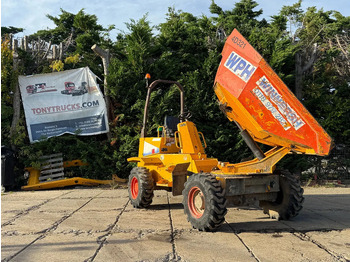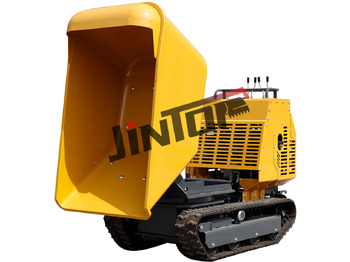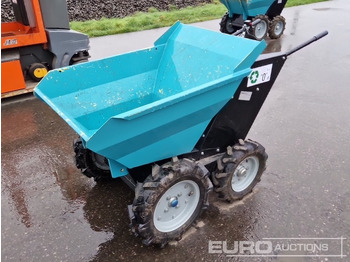Mini dumper 13.5HP Powerful Mini Dumper Crawler Transporter Small Dump Truck with Lifting function
Published: 21d
Published: 21d
Leasing
Available on requestThe lifting dump truck is a type of engineering transport vehicle with unique lifting and tipping functions. Its design combines the characteristics of a lifting mechanism and a tipping discharge, demonstrating significant advantages in various operational scenarios. Core Advantages of Lifting Dump Trucks
1. Efficient Discharge and Adaptability to Complex Terrains - Convenient Discharge: Through a hydraulic lifting system, the truck bed can be tilted to a specified angle (typically 40°–60°), allowing materials (such as sand, soil, construction waste, etc.) to be quickly unloaded by gravity. Compared with traditional trucks that require manual assistance for unloading, efficiency is improved by over 30%. - Strong Terrain Adaptability: The lifting function adjusts the bed height, enabling precise control of the discharge position in uneven construction sites, slopes, or low-clearance spaces (e.g., underground garages, tunnels). This prevents material spillage or obstruction. For example, when building roads in mountainous areas, stones can be directly unloaded to designated areas by cliffs, reducing secondary handling. 2. Flexible Loading and Wide Load Range - Multi-scenario Loading Capacity: The bed size and load capacity can be customized (common loads range from 5 to 30 tons), capable of carrying both bulk materials and large components (such as precast concrete blocks, steel) by adding fences. Some models also support detachable or foldable beds to adapt to different cargo types. - High Space Utilization: The lifting function lowers the bed height, facilitating loading and unloading in low warehouses or containers. For instance, goods can be directly loaded from low loading docks into the bed, reducing forklift reliance and saving warehousing costs. 3. Safe Operation and Reduced Labor Intensity - Automated Control: The hydraulic lifting system is operated via buttons or remote control, minimizing safety hazards (e.g., falls, material collapse) from manual climbing to unload, especially suitable for transporting hazardous materials like construction waste. - Stability Design: The vehicle is equipped with anti-tip supports and a balancing system to maintain stability during lifting and avoid rollover risks. For example, when unloading on muddy construction sites, the supports can extend to the ground to enhance grip and ensure safe operation. 4. Multi-functional Expansion and High Cost-effectiveness - Integrated Additional Functions: Some models can be equipped with sprinkler systems (to reduce dust when transporting powdery materials), sealed tarpaulins (to prevent spillage), or weighing systems (to monitor load in real time), meeting environmental and metering requirements. - Low Lifecycle Cost: Compared with the combination of a loader and a truck, a single lifting dump truck can complete multiple tasks such as "transportation + unloading + short-distance handling," reducing equipment procurement and maintenance costs, making it suitable for small and medium engineering teams.
Typical Application Scenarios of Lifting Dump Trucks
1. Construction Engineering and Infrastructure Development - Construction Site Material Transportation: During building construction, transport concrete and bricks to the bottom of high-rise tower cranes, directly docking with the crane hopper via the lifting function; during road construction, unload asphalt materials in front of pavers for continuous paving operations. - Earthwork Projects: Transport ores to crushing stations in mining, or precisely unload soil to designated areas during foundation backfilling, avoiding manual relaying.
2. Municipal Sanitation and Waste Treatment - Garbage Collection: In urban waste transfer stations, lifting dump trucks can directly pour garbage from bins into the bed and unload it into compression equipment via the tipping function, reducing odor diffusion and environmental pollution from manual dumping. - Municipal Construction: Transport sludge to treatment plants during sewer dredging; transport seedlings and fertilizers to green belts in landscaping, improving planting efficiency. 3. Agriculture and Animal Husbandry - Agricultural Product Transportation: Transport grains and feeds on farms, with tipping discharge directly into granaries or livestock feeding troughs; during orchard harvesting, unload fruits onto sorting tables to reduce manual handling losses. - Animal Husbandry Applications: Transport manure from farms to composting areas, with the lifting function adjusting the bed height to dock with manure treatment equipment for automated unloading.
4. Industry and Warehousing Logistics - Factory Material Transfer: Transport slag in steel plants and cement clinker in cement plants, with tipping discharge directly into storage tanks; transport palletized goods in warehousing, where the lifting function adapts to shelves of different heights. - Ports and Docks: Short-distance transport of containers or bulk goods (such as ores, coal), cooperating with cranes to complete ship loading and unloading operations and improving logistics turnover efficiency.
5. Special Scenario Applications - Emergency Rescue: In disasters like earthquakes and floods, transport relief supplies to damaged road areas, with the lifting function enabling unloading beside obstacles (e.g., sandbags into riverbank gaps); during forest fires, transport fire-fighting equipment to rough mountain roads and quickly unload to fire points. With the characteristics of "efficient unloading, flexible loading, and safe control," the lifting dump truck has become an important equipment in engineering, municipal, agricultural, and other fields. Its advantages not only lie in a single transportation link but also optimize the entire material handling process through functional integration, especially suitable for scenarios with high requirements for operational efficiency and terrain adaptability. When selecting a model, further refinement can be based on load requirements, terrain conditions, and additional functions (such as environmental configurations) to maximize equipment value.
EngineModel: BRIGGS STRATTON 420
EngineType: Single cylinder, OHV, 4-stroke, air cooling
displacement(ML): 420CC
RatedPower(kw/rpm): 13.5HP/3600rpm
FuelType: 92 #Gasoline
FuelConsumption(g/kw·h): ≤0.7
Fuel Tank capacity(L): 6.5
Engine oil capacity(L): 1.1
Total Weight: 880(KG)
Max loading weighthorizontal transport: 1000(KG)
Max. Lifting load: 550(KG)
Machin size(Without pedal, without bucket)(MM): 1800*880*1920
Bucket size with foot pedal(MM): 2700*880*1920
Container size(MM): 1220*800*600
Chassis width(MM): 850
Max lifting discharge height(MM): 1500
Tipping interval(MM): 350
track width:(MM): 180
Track grounding length(MM): 915
Chassis ground clearance(MM): 100
Cargo box Capacity(m³): 290
Tipping Systme: HydraulicTipper
TiltingAngle(°): 100
Walking Speed: 3
Minimum Turning radius(MM): 1300
Track gauge(MM): 670
Chassis ground clearance(MM): 100
Climbing abillty(°): 25
Hopper
This offer is for informational purposes only. Please confirm details directly from the seller.
After identifying a vehicle of interest on Truck1.eu, you have the option to reach out to the seller either by using the contact form or by calling the dealer directly using the phone number provided. Choose the method that best aligns with your preferences.
Reach out to the seller to request more information about the vehicle’s availability, technical condition, and actual price, as ads might not always provide complete details. Additionally, ask for any recent service records or inspection reports to get a clearer picture of the vehicle’s current state.
Leverage Truck1’s comparison feature to evaluate similar vehicles. This will help you assess whether the asking price is competitive and aligned with market trends. Look for patterns in pricing and features to make an informed decision.
When purchasing a vehicle online, it's essential to verify the seller's reputation by looking for positive reviews and a history of successful transactions. Truck1’s “Dealer status” icons provide valuable insights based on the experiences with the dealer, aiding in assessing the seller’s reliability.
Whenever possible, make it a priority to visit the seller and inspect the vehicle in person. If feasible, arrange for a third-party pre-purchase inspection of the vehicle. This can uncover potential issues that might not be visible in photos or mentioned in the advert.
Ensure you sign a detailed sale agreement to protect your rights and confirm the terms of the transaction.
Proceed with payment only after signing the sale agreement. A small down payment to reserve the vehicle is common but should be done cautiously.
Confirm the seller's authenticity by gathering detailed information and checking reviews or ratings from previous buyers. Look for dealer icons on Truck1 to identify verified sellers and ensure a safer purchasing experience.
Compare the prices of similar vehicles using the Comparison tool to identify any unusual offers. Be wary of prices that deviate significantly from the market norm, as they may indicate potential issues or fraud.
Ask the seller for details about the vehicle’s history and usage conditions. A genuine seller will be transparent and willing to share this information, helping you assess if the vehicle meets your needs.
Arrange to see and test the vehicle, looking for signs of wear or damage. Consider a pre-purchase inspection by a professional mechanic to uncover any hidden issues and ensure the vehicle's safety and reliability.
Before any transaction, ensure a detailed sale agreement is in place outlining all terms and conditions. Use secure payment methods and verify transaction details to protect against fraud.
Leasing
Available on request
This offer is for informational purposes only. Please confirm details directly from the seller.
After identifying a vehicle of interest on Truck1.eu, you have the option to reach out to the seller either by using the contact form or by calling the dealer directly using the phone number provided. Choose the method that best aligns with your preferences.
Reach out to the seller to request more information about the vehicle’s availability, technical condition, and actual price, as ads might not always provide complete details. Additionally, ask for any recent service records or inspection reports to get a clearer picture of the vehicle’s current state.
Leverage Truck1’s comparison feature to evaluate similar vehicles. This will help you assess whether the asking price is competitive and aligned with market trends. Look for patterns in pricing and features to make an informed decision.
When purchasing a vehicle online, it's essential to verify the seller's reputation by looking for positive reviews and a history of successful transactions. Truck1’s “Dealer status” icons provide valuable insights based on the experiences with the dealer, aiding in assessing the seller’s reliability.
Whenever possible, make it a priority to visit the seller and inspect the vehicle in person. If feasible, arrange for a third-party pre-purchase inspection of the vehicle. This can uncover potential issues that might not be visible in photos or mentioned in the advert.
Ensure you sign a detailed sale agreement to protect your rights and confirm the terms of the transaction.
Proceed with payment only after signing the sale agreement. A small down payment to reserve the vehicle is common but should be done cautiously.
Confirm the seller's authenticity by gathering detailed information and checking reviews or ratings from previous buyers. Look for dealer icons on Truck1 to identify verified sellers and ensure a safer purchasing experience.
Compare the prices of similar vehicles using the Comparison tool to identify any unusual offers. Be wary of prices that deviate significantly from the market norm, as they may indicate potential issues or fraud.
Ask the seller for details about the vehicle’s history and usage conditions. A genuine seller will be transparent and willing to share this information, helping you assess if the vehicle meets your needs.
Arrange to see and test the vehicle, looking for signs of wear or damage. Consider a pre-purchase inspection by a professional mechanic to uncover any hidden issues and ensure the vehicle's safety and reliability.
Before any transaction, ensure a detailed sale agreement is in place outlining all terms and conditions. Use secure payment methods and verify transaction details to protect against fraud.

















